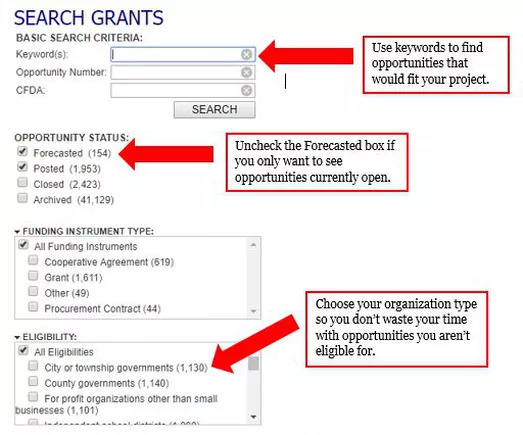Has your month been as busy as ours? It seems that we pack a LOT of stuff into the month of October.
Fall is also a great time to start looking for federal grant opportunities for your organization. The federal fiscal year begins in October so this is when we start to see more Notice of Funding Announcements (NOFAs) released from all the federal agencies. If you’ve ever applied for a federal grant or even opened a NOFA, you know there is a lot involved in submitting a successful application.
Whether you’re new to federal grants or an expert, here are 10 steps to ensure this year’s federal grant writing season goes off without a hitch:
REGISTER
To apply for a federal grant, you must first register. This is a 5-step process that includes securing a DUNS number and registering with the System for Award Management (SAM). The process is simple enough and Grants.gov even provides step-by-step instructions on organization registration. Just be sure you give yourself at least three weeks to complete all five steps. If you’re not registered in time, you won’t be able to submit your application!
GET YOUR DOCUMENTS READY
Every application will require a different set of attachments but there are some common ones you can expect to submit when applying for any type of grant. These include a copy of your IRS tax exempt letter, a list of current board members, an annual operating budget, and a program/project budget. Other documents you might see include letters of support or commitment from your partners, job descriptions for current or future program staff, resumes of key staff, and formal agreements outlining what each partner will do if awarded.
THINK ABOUT YOUR PERFECT MATCH
Before you start searching for federal grants, make a list of all the programs or projects you would expand or implement if you had extra money. Ideally, these programs or projects will be in line with your mission and will address a need in your community. I know what you’re thinking right now… “This is pointless; I know what my mission is and I would only apply for grants to support my mission”. Trust me, as soon as you start finding 6-figure funding opportunities, you’ll be tempted to expand your focus just a liiiittle bit.
FIND A GOOD MATCH
There are a few places to search for federal grants but I find the Grants.gov search engine to be the easiest to use. Unless you want to scroll through thousands of opportunities, set up your search criteria on the left-hand side of the page (check out the helpful tips below!). Set aside time to search once a week because the time from NOFA release to due date can be short. When you go back each week, you can sort the opportunities by release date so you don’t look at the same ones again. Another way to save time is to sign up for newsletters or alerts from federal agencies that do similar work as your organization. For example, if you provide substance abuse counseling, you could sign up for alerts from the Substance Abuse and Mental Health Services Administration.

CHECK FOR ELIGIBILITY
Once you’ve found an opportunity you believe is a good match, you want to make sure you’re eligible. Even if you limited your search by organization type, there may be other specific eligibility requirements you don’t meet so be sure to read the eligibility section of the NOFA.
READ THE NOFA
Block off at least half a day to really dig into the announcement. I find it helpful to create a basic table of all the major sections with supporting details and requirements to ensure I don’t miss any details. If you’re working with a group of folks, it’s also helpful to add in a column to show who’s responsible and the status of the section. Make sure to note the due dates for the notice/letter of intent (if applicable) and the final due date.
While you’re pulling out details on all the major sections you’ll need to include, pay special attention to any documents you’ll need to gather from your partners. Some of the most common documents include letters of support and memoranda of agreement/understanding. These documents should be your top priority since it will take your partners time to create or review documents and secure all the proper signatures.
WRITE
This may be the most dreaded step for some of you but there’s no avoiding it. The time it will take to write the narrative and compile all the attachments will vary based on your experience and the length of the application. As a general rule of thumb, plan for somewhere between 80 and 120 hours. Block off as much uninterrupted time as possible to get the writing done.
BACK AWAY FROM THE COMPUTER
Build in enough time (days, not hours!) to step away from your application before you complete your final review and edits. If you’re able to have someone else review the application, that’s even better!
HIT SUBMIT
And do it BEFORE the due date/time! Imagine the sheer panic you’ll experience if you get to 11:57 p.m. on the due date and your internet goes out or your laptop battery dies. Don’t take the chance.
CELEBRATE
Writing a federal grant proposal requires a lot of attention to detail, long days sitting in front of a computer, and endless patience waiting for documents to be signed. If you made it through, it’s time to treat yourself!
Interested in finding or applying for federal grants but need an extra hand? Learn more about how we can help you – Work With Us.
Do you have other great tips for making it through federal grant season? Please comment below!
- How to streamline your grant process - November 2, 2021
- Should your nonprofit add a new program or service? - April 27, 2021
- How to tell if a federal grant is a good fit - April 13, 2021
